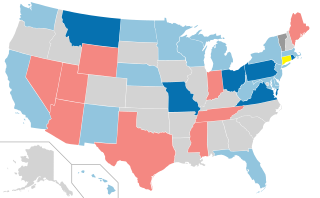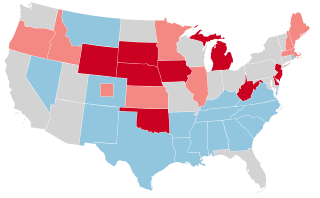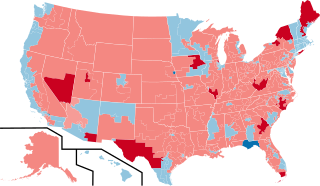
Midterm elections in the United States are the general elections that are held near the midpoint of a president's four-year term of office, on Election Day on the Tuesday after the first Monday in November. Federal offices that are up for election during the midterms include all 435 seats in the United States House of Representatives, and 33 or 34 of the 100 seats in the United States Senate.

The 2006 United States elections were held on Tuesday, November 7, 2006, in the middle of Republican President George W. Bush's second term. In a political revolution that broke twelve years of Republican rule, the Democratic Party was swept into majorities in Congress, the governorships, and state legislatures across the country. This marked the first and only time either party achieved such a feat since the 1994 elections. These elections were widely categorized as a Democratic wave.

The 2006 Illinois elections were held on November 7, 2006. On that date, registered voters in the State of Illinois elected officeholders for U.S. Congress, to six statewide offices, as well as to the Illinois Senate and Illinois House.

Elections in the U.S. state of New Hampshire are held at national, state and local level. The state holds the first presidential primary in the national cycle. Elections for a range of state positions coincide with biennial elections for the House of Representatives.

The 2010 United States elections were held on Tuesday, November 2, 2010, in the middle of Democratic President Barack Obama's first term. Republicans ended unified Democratic control of Congress and the presidency by winning a majority in the House of Representatives and gained seats in the Senate despite Democrats holding Senate control.

The 2002 United States elections were held on November 5, in the middle of Republican President George W. Bush's first term. Republicans won unified control of Congress, picking up seats in both chambers of Congress, making Bush the first President since Franklin D. Roosevelt in 1934 to gain seats in both houses of Congress. In the gubernatorial elections, Democrats won a net gain of one seat. The elections were held just a little under fourteen months after the September 11 attacks. Thus, the elections were heavily overshadowed by the War on Terror, the impending Iraq War.

The 2012 United States elections took place on November 6, 2012. Democratic President Barack Obama won reelection to a second term and the Democrats gained seats in both chambers of Congress, retaining control of the Senate even though the Republican Party retained control of the House of Representatives. As of 2024, this is the most recent election cycle in which neither the presidency nor a chamber of Congress changed partisan control, and the last time that the party that won the presidency simultaneously gained seats in both the House of Representatives and the Senate.

Elections in Virginia are authorized under Article I of the Virginia State Constitution, sections 5–6, and Article V which establishes elections for the state-level officers, cabinet, and legislature. Article VII section 4 establishes the election of county-level officers. Elections are regulated under state statute 24.2-102. The Virginia State Board of Elections oversees the execution of elections under state law. In a 2020 study, Virginia was ranked as the 12th easiest state for citizens to vote in.

Elections were held in Illinois on Tuesday, November 2, 2010. Primary elections were held on February 2, 2010.

The 1942 United States elections were held on November 3, 1942, and elected the members of the 78th United States Congress. In Democratic President Franklin D. Roosevelt's unprecedented third mid-term election and during World War II, the Republican Party picked up seats in both chambers. Still, the Democrats retained control of Congress.

The 2014 United States House of Representatives elections were held on November 4, 2014, in the middle of President Barack Obama's second term in office. Elections were held for all 435 seats of the House of Representatives, representing the 50 states. Elections were also held for the non-voting delegates from the District of Columbia and four of the five territories. The winners of these elections served in the 114th United States Congress, with seats apportioned among the states based on the 2010 United States census.

The 2018 United States Senate elections were held on November 6, 2018. Among the 100 seats, the 33 of Class 1 were contested in regular elections while 2 others were contested in special elections due to Senate vacancies in Minnesota and Mississippi. The regular election winners were elected to 6-year terms running from January 3, 2019, to January 3, 2025. Senate Democrats had 26 seats up for election, while Senate Republicans had 9 seats up for election.

The 2016 United States elections were held on Tuesday, November 8, 2016. Republican nominee Donald Trump defeated Democratic former Secretary of State Hillary Clinton in the presidential election, while Republicans retained control of Congress. This marked the first and most recent time Republicans won or held unified control of the presidency and Congress since 2004.

The 2018 United States elections were held on Tuesday, November 6, 2018. These midterm elections occurred during Incumbent Republican President Donald Trump's term. Although the Republican Party increased its majority in the Senate, unified Republican control of Congress and the White House was brought to an end when the Democratic Party won control of the House of Representatives in what was widely characterized as a "blue wave" election as Democrats also gained governorships, other statewide offices, and state legislative chambers.

A general election was held in the U.S. state of Illinois on November 6, 2018. The elections for Illinois's 18 congressional districts, Governor, statewide constitutional officers, Illinois Senate, and Illinois House were held on this date.

The 2018 United States House of Representatives elections were held on November 6, 2018, as part of the 2018 midterm elections during President Donald Trump's term, with early voting taking place in some states in the weeks preceding that date. Voters chose representatives from all 435 congressional districts across each of the 50 U.S. states to serve in the 116th United States Congress. Non-voting delegates from the District of Columbia and four of the five inhabited U.S. territories were also elected. On Election Day, Republicans had held a House majority since January 2011.

The 2022 United States elections were held on November 8, 2022, with the exception of absentee balloting. During this U.S. midterm election, which occurred during the term of incumbent president Joe Biden of the Democratic Party, all 435 seats in the U.S. House of Representatives and 35 of the 100 seats in the U.S. Senate were contested to determine the 118th United States Congress. Thirty-nine state and territorial U.S. gubernatorial elections, as well as numerous state and local elections, were also contested. This was the first election affected by the 2022 U.S. redistricting that followed the 2020 U.S. census. The Republican Party ended unified Democratic control of Congress and the presidency by winning a majority in the House of Representatives while the Democrats expanded their Senate majority.

Elections were held in Illinois on Tuesday, November 5, 2002. Primary elections were held on March 19, 2002.

Elections were held in Illinois on Tuesday, November 3, 1998. Primary elections were held on March 17, 1998.

Elections were held in Illinois on Tuesday, November 8, 1994. Primaries were held on March 15, 1994.
















